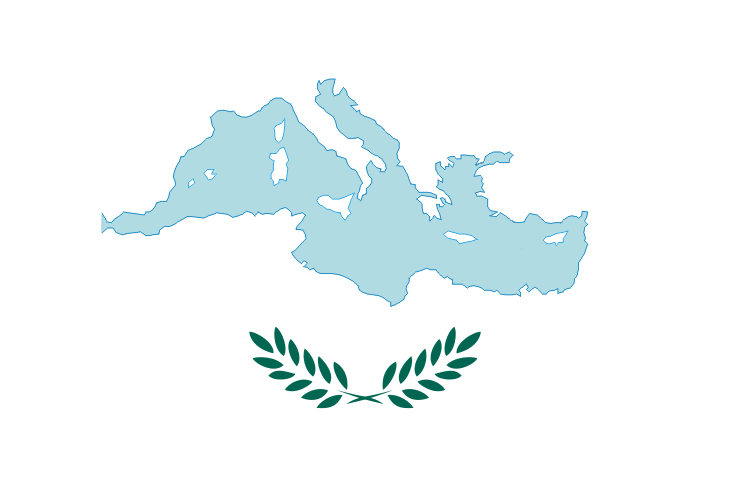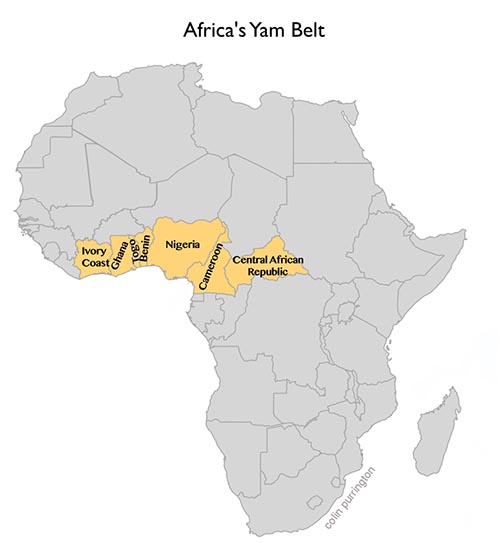

 African
African  Portugal
Portugal  Spain Creole, Portuguese, African and Brazilian gastronomy have all influenced the food and drink of the isles.
Spain Creole, Portuguese, African and Brazilian gastronomy have all influenced the food and drink of the isles.Moambe: DRC’s national dish consisting of chicken or fish with cassava leaves, hot pepper sauce, bananas, rice, peanuts, fish, chicken, and palm nuts.
Chikwanga: Cassava cooked and stored in banana leaves.
Fufu: A sticky, dough-like staple made from cassava flour.
Pili Pili: Hot chilli sauce or paste served with almost everything.
Satori: A tasty fish dish consisting of tilapia fillets fried with pumpkin seeds, plantains and garlic.
Saka Saka: Ground cassava leaves cooked with palm oil, peanut paste, beans and salt fish.
Maboke: A freshwater fish cooked in large marantacee leaves.
Linguila: A wine made from fermented sugar cane.
Palm wine: A tipple made from the sap of palm trees and fermented by natural yeasts.
White elephant: A popular alcoholic drink made from rum, coconut and milk.
Djibouti‘s cuisine is heavily influenced by its neighbors, Ethiopia, Somalia and Yemen, as well as its former occupier France, and by India to some extent. Being a hotspot on the old Spice Road that made its way to Timbuktu, the country has a range of dishes that are as unique as their origin.
more....Meals typically consist of meat or fish served with stewed vegetables and a sauce, generally sporting very hot chilli flavours. Having maintained strong links with France since independence, French staples such as croissants and baguettes can be found in the cities.
In more rural areas of the country, dishes tend to be simpler, relying on cassava, rice or yams. Bush meat such as monkey and antelope has been a traditional part of the Gabonese diet.
Braised fish: Bass or red fish braised with chilli flavours and served with rice or French fries.Gabonese food is a distinctive and delicious blend of traditional African ingredients and French flavours, though it jostles for space on local menus with Senegalese, Cameroonian and Congolese dishes, which are commonly served here.
Meals typically consist of meat or fish served with stewed vegetables and a sauce, generally sporting very hot chilli flavours. Having maintained strong links with France since independence, French staples such as croissants and baguettes can be found in the cities.
In more rural areas of the country, dishes tend to be simpler, relying on cassava, rice or yams. Bush meat such as monkey and antelope has been a traditional part of the Gabonese diet.
Braised fish: Bass or red fish braised with chilli flavours and served with rice or French fries.
Skillet chicken and rice more....Jollof rice: Rice cooked with palm oil, tomato paste and onions, to which other vegetables and meat or fish are added.
Egusi soup: Soup thickened with the ground seeds of squashes. It usually contains green vegetables and sometimes tomatoes and onions.
Yassa chicken: Common across West Africa, this dish features chicken cooked in an onion and tomato sauce.
Fried cassava: Deep-fried yucca or cassava makes a tasty treat.
Fish stew: A Portuguese inspired dish of seafood in a salty broth.
Avocados with tuna: A salad of avocado, tuna and tomatoes.
Grilled prawns: Particularly common by the coast.
Ravias: Portuguese inspired cinnamon cookies, often sold in bakeries.
Cashew nuts: Delicious and plentiful in season, sometimes made into juice.
Cana de cajeu: Rum made from the fruit of the cashew.
Palm wine: Commonly made in rural areas. Alcohol levels depend on how long it has been left to ferment. It tastes better than it smells.
 France
France  India
India  Mediterranean
Mediterranean 

 France
France  India
India
Non-liquid ingredients in volume converted
|
|||||||
|---|---|---|---|---|---|---|---|
Ingredient |
1 cup |
3/4 cup |
2/3 cup |
1/2 cup |
1/3 cup |
1/4 cup |
2 tablespoons |
| All-purpose wheat flour | 120 g | 90 g | 80 g | 60 g | 40 g | 30 g | 15 g |
| All-purpose sifted wheat flour | 110 g | 80 g | 70 g | 55 g | 35 g | 27 g | 13 g |
| White sugar | 200 g | 150 g | 130 g | 100 g | 65 g | 50 g | 25 g |
| Powdered sugar/Icing sugar | 100 g | 75 g | 70 g | 50 g | 35 g | 25 g | 13 g |
| Brown sugar normally packed | 180 g | 135 g | 120 g | 90 g | 60 g | 45 g | 23 g |
| Corn flour | 160 g | 120 g | 100 g | 80 g | 50 g | 40 g | 20 g |
| Cornstarch | 120 g | 90 g | 80 g | 60 g | 40 g | 30 g | 15 g |
| Rice (not-cooked) | 190 g | 140 g | 125 g | 95 g | 65 g | 48 g | 24 g |
| Macaroni (uncooked) | 140 g | 100 g | 90 g | 70 g | 45 g | 35 g | 17 g |
| Couscous (uncooked) | 180 g | 135 g | 120 g | 90 g | 60 g | 45 g | 22 g |
| Quick oatmeal (uncooked) | 90 g | 65 g | 60 g | 45 g | 30 g | 22 g | 11 g |
| Table salt | 300 g | 230 g | 200 g | 150 g | 100 g | 75 g | 40 g |
| Butter / Margarine | 240 g | 180 g | 160 g | 120 g | 80 g | 60 g | 30 g |
| Shortening | 190 g | 140 g | 125 g | 95 g | 65 g | 48 g | 24 g |
| Fruits and légumes chopped | 150 g | 110 g | 100 g | 75 g | 50 g | 40 g | 20 g |
| chopped walnuts | 150 g | 110 g | 100 g | 75 g | 50 g | 40 g | 20 g |
| Nuts /ground almonds | 120 g | 90 g | 80 g | 60 g | 40 g | 30 g | 15 g |
| Fresh bread crumbs (not packed) | 60 g | 45 g | 40 g | 30 g | 20 g | 15 g | 8 g |
| Dry bread crumbs | 150 g | 110 g | 100 g | 75 g | 50 g | 40 g | 20 g |
| Parmesan grated | 90 g | 65 g | 60 g | 45 g | 30 g | 22 g | 11 g |
| Chocolate chips | 150 g | 110 g | 100 g | 75 g | 50 g | 38 g | 19 g |